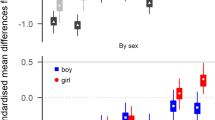Abstract
Sixty-eight 2-and 3-year-olds (46 parent-referred, 22 controls) participating in an identification, assessment, and follow-up study of hyperactivity and related behavior problems were evaluated on parent-report, observational, and cognitive measures. Referred youngsters were described by both parents as more active, inattentive, difficult to discipline, and aggressive with peers than were controls. Mothers of referred children also reported a more difficult infancy period. Laboratory assessments confirmed parental reports of current problems. Referred children shifted activities more during free play, were more active and inattentive during structured tasks, and made more impulsive responses on a delay task than did controls. Discriminant function analysis indicated that parental ratings of activity paired with laboratory measures of sustained attention and impulsivity correctly classified 88% of the sample. These data suggest that the core symptoms of hyperactivity can be identified in very young children, although their prognostic significance remains to be determined.
Similar content being viewed by others
Reference note
Bates, J. E., Pettit, G. S., & Bayles, K.Antecedents of behavior problems at age three years. Boston: Society for Research in Child Development, 1981.
References
American Psychiatric Association.Diagnostic and statistical manual of mental disorders (DSM-III). Washington, D.C., 1980.
Barkley, R. A., Specific guidelines for defining hyperactivity (attention deficit disorder) in children. In B. Lahey & A. Kazdin (Eds.),Advances in child clinical psychology (Vol. 4). New York: Plenum, 1981.
Behar, L. The Preschool Behavior Questionnaire.Journal of Abnormal Child Psychology, 1977,5, 265–276.
Buss, D. M., Block, J. H., & Block, J. Preschool activity level: personality correlates and developmental implications.Child Development, 1980,51, 401–408.
Campbell, S. B. Hyperactivity: Course and treatment. In A. Davis (Ed.),Child personality and psychopathology (Vol. 3). New York: Wiley, 1976.
Campbell, S. B., & Cluss, P. Peer relationships of young children with behavior problems. In K. H. Rubin & H. S. Ross (Eds.),Peer relationships and social skills in childhood. New York: Springer-Verlag, 1982.
Campbell, S. B., Endman, M., & Bernfeld, G. A three-year follow-up of hyperactive preschoolers into elementary school.Journal of Child Psychology and Psychiatry, 1977,18, 239–250.
Campbell, S. B., Schleifer, M., Weiss, G., & Perlman, T. A two-year follow-up of hyperactive preschoolers.American Journal of Orthopsychiatry, 1977,47, 149–162.
Coates, S. W.Preschool Embedded Figures Test. Palo Alto, California: Consulting Psychologists Press, 1972.
Douglas, V. I. Treatment and training approaches to hyperactivity: Establishing external or internal control. In C. K. Whalen & B. Henker (Eds.),Hyperactive children: The social ecology of identification and treatment. New York: Academic Press, 1980.
Douglas, V. I., Parry, P., Marton, P. M., & Garson, C. Assessment of a cognitive training program for hyperactive children.Journal of Abnormal Child Psychology, 1976,4, 389–410.
Foster, F. G., McPartland, R. J., & Kupfer, D. J. Motion sensors in medicine, Part I. A report on reliability and validity.Journal of Inter-American Medicine, 1978,3, 4–8.
Golden, M., Montare, A., & Bridger, W. Verbal control of delay behavior in two year old boys as a function of social class.Child Development, 1977,48, 1107–1111.
Halverson, C. F., & Waldrop, M. F. The relations of mechanically recorded activity level to varieties of preschool play behavior.Child Development, 1973,44, 678–681.
Halverson, C. F., & Waldrop, M. Relations between preschool activity and aspects of intellectual and social behavior at age 71/2.Developmental Psychology, 1976,12, 107–112.
Henker, B., & Whalen, C. K. The changing faces of hyperactivity: Retrospect and prospect. In C. K. Whalen & B. Henker (Eds.),Hyperactive children: The social ecology of identification and treatment. New York: Academic Press, 1980.
Kagan, J. Reflection-impulsivity: The generality and dynamics of conceptual tempo.Journal of Abnormal Psychology, 1966,71, 17–24.
Kagan, J.Change and continuity in infancy. New York: Wiley, 1971.
Kohn, M.Social competence, symptoms, and underachievement in childhood: A longitudinal perspective. Washington, D.C.: V. H. Winston, 1977.
Kohn, M., & Parnes, B. Social interaction in the classroom — A comparison of apathetic-withdrawn and angry-defiant children.Journal of Genetic Psychology, 1974,125, 165–175.
Lahey, B. B., Green, K. D., & Forehand, R. On the independence of ratings of hyperactivity, conduct problems, and attention deficits in children: A multiple regression analysis.Journal of Consulting and Clinical Psychology, 1980,48, 566–574.
Maccoby, E., Dowley, E., Hagen, J., & Degerman, R. Activity level and intellectual functioning in normal preschool children.Child Development, 1965,36, 761–770.
Minde, K. K., Weiss, G., & Mendelson, N. A five-year follow-up study of 91 hyperactive school children.Journal of the American Academy of Child Psychiatry, 1972,11, 595–610.
Ross, D. M., & Ross, S. A.Hyperactivity: Theory, research, and action. New York: Wiley, 1976.
Routh, D., Schroeder, C., & O'Tuama, L. Development of activity level in children.Developmental Psychology, 1974,10, 163–168.
Sandberg, S., Rutter, M., & Taylor, E. Hyperkinetic disorder in psychiatric clinic attenders.Developmental Medicine and Child Neurology, 1978,20, 279–299.
Schleifer, M., Weiss, G., Cohen, N. J., Elman, M., Cvejic, H., & Kruger, E. Hyperactivity in preschoolers and the effect of methylphenidate.American Journal of Orthopsychiatry, 1975,45, 38–50.
Thomas, A., Chess, S., & Birch, H. G.Temperament and behavior disorders in children. New York: New York University Press, 1968.
Weiss, G., Hechtman, L., Perlman, T., Hopkins, J., & Wener, A. Hyperactives as young adults: A controlled prospective ten-year follow-up of 75 children.Archives of General Psychiatry, 1979,36, 675–681.
Weiss, G., Kruger, E., Danielson, U., & Elman, M. The effect of long-term treatment of hyperactive children with methylphenidate.Canadian Medical Association Journal 1975,112, 159–164.
Author information
Authors and Affiliations
Additional information
This research was supported by Grant No. R01 MH 32735 from the National Institute of Mental Health to the first author. Thanks are due to the parents and children who participated so enthusiastically in this study. The dedication of Patricia Cluss is gratefully acknowledged. Mady Fingeret, Frank McKee, Jenny Palermo, Susan Riley, Elizabeth Schaughency, Sheree Thomas, and Russell Walters are also thanked for their help in data collection.
Rights and permissions
About this article
Cite this article
Campbell, S.B., Szumowski, E.K., Ewing, L.J. et al. A multidimensional assessment of parent-identified behavior problem toddlers. J Abnorm Child Psychol 10, 569–591 (1982). https://doi.org/10.1007/BF00920755
Revised:
Issue Date:
DOI: https://doi.org/10.1007/BF00920755




